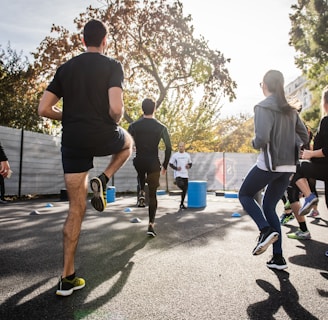Bridging Gaps: Making Fitness Accessible for All
Let’s explore how technology, design, and engineering can make fitness truly accessible for all.
Remi Voisin
10/23/20243 min read


Modern Fitness is about health, longevity, and well-being. However, despite the numerous advancements in the fitness industry, there are still gaps preventing access to all. From a lack of inclusive facilities to digital divides, the challenge is to create a universally accessible fitness ecosystem.
As an engineer by profession and a fitness enthusiast, I believe the future lies in blending innovation with empathy to bridge these gaps.
“Technology has the power to democratize fitness, but we need to ensure that this revolution includes everyone—not just the tech-savvy or affluent.” — John Peters, Fitness Tech Consultant.
Let’s explore how technology, design, and engineering can make fitness truly accessible for all.
The Accessibility Problem in Fitness
Physical limitations:
Day-Time affluence and inclusivity in gyms and fitness platforms can impact people who often find it challenging to access the equipment or services tailored to their needs. Other considerations such as disabilities, gender or groups could be a key topic to address by professionals to improvement engagement.
Geographical limits:
Rural areas often lack quality fitness centers or outdoor facilities, leaving many without access to fitness professionals or equipment, whilst urban areas may benefit from a number of sports and fitness centers, access to dedicated outdoor equipped zones is limited. Subsidized fitness centers and community outreach programs can be essential in bridging this gap
Economic inequality:
Gym membership fees and costly equipment can leave fitness out of reach for a large population, especially if individuals have no smart objectives set in mind. Many fitness studios are embracing sliding scale pricing or offering subsidized options, making fitness more affordable for different income levels. This is particularly important in underserved communities where cost barriers remain a significant hurdle
Source: World Health Organization (WHO) / HealthCareBloggers
How Engineering Can Help ?
Modular and Adaptive Gym Equipment - focused on ergonomy
Performance tracking and real-time feedback - using AI and machine learning
Digital Twins in Fitness - for personalisation
Virtual Fitness Solutions - hybrid models
Open-Source Platforms - encourage innovation driving inclusivity in tech solutions.
Low-bandwidth fitness apps - democratized access to fitness content.
“Engineering in fitness goes beyond equipment. It’s about designing experiences that cater to a diverse audience, removing barriers, and promoting wellness for all.” — Dr. Emily Thompson, Biomedical Engineer.
The Role of Wearable Tech and AI
In recent years, wearable technology has become mainstream, tracking everything from steps to heart rate. However, the next step is making this technology more inclusive and adaptive.
Adaptive Wearable Tech:
Devices like smartwatches and fitness bands are continuously improving, but most are designed for able-bodied users. What about designing wearables that monitor the health and movement of people with physical impairments, offering customized feedback. Some companies pionneer vocal or vibration-based cues for users with visual or hearing impairments.
AI Personalization:
The rise of artificial intelligence in fitness is undeniable. AI-based personal training apps and platforms offer scalability and personalization. These solutions could serve a broader population if designed with accessibility in mind. AI-based virtual trainers should be programmed to consider different mobility levels, offering adaptive exercises and recovery routines. Let's not forget that mobility and recovery are essential to perform and progress in any sports.
Source: According to research from Deloitte, the wearable tech market is forecast to grow 12% annually, with personalization driving the trend .
Reducing the Digital Divide
Fitness is increasingly digital, with apps, virtual classes, and wearables driving the future of health. However, this shift comes with its challenges, especially for populations without access to the necessary technology or skills to engage with digital fitness platforms.
Community-Driven Fitness Spaces:
Engaging with the public outside of business facilities has seen initiatives often involving partnerships between local governments, businesses, and community groups to create accessible outdoor workout areas, pop-up classes in parks, or free fitness events. These spaces are designed to break down the barriers that prevent people from accessing traditional fitness facilities, such as cost and location. For example, many cities have implemented outdoor gyms with free-to-use equipment and organized group exercise sessions, which foster a sense of community and inclusivity.
Inclusive Digital Platforms:
There is a pressing need for simpler, more user-friendly fitness apps that cater to different age groups and skill levels, as well as accessibility features, such as audio descriptions for the visually impaired or tutorials in multiple languages.
Conclusion: A Vision for Inclusive Fitness
Welcoming environments, thoughtful design, technological innovation, and community-driven approaches, we . these spaces not only encourage regular physical activity but also foster social connections. Research shows that when people feel a sense of belonging and support in their fitness journeys, they are more likely to stick with their routines.
This model of engagement emphasizes inclusivity, ensuring that fitness is accessible to everyone, regardless of socioeconomic background or physical ability. Moreover, offering these programs outside traditional business hours and locations ensures a broader audience can participate, reinforcing the idea that fitness should be a universal opportunity.
Bridging the gap is not just about inclusion—it’s about reshaping the fitness landscape for the better.
